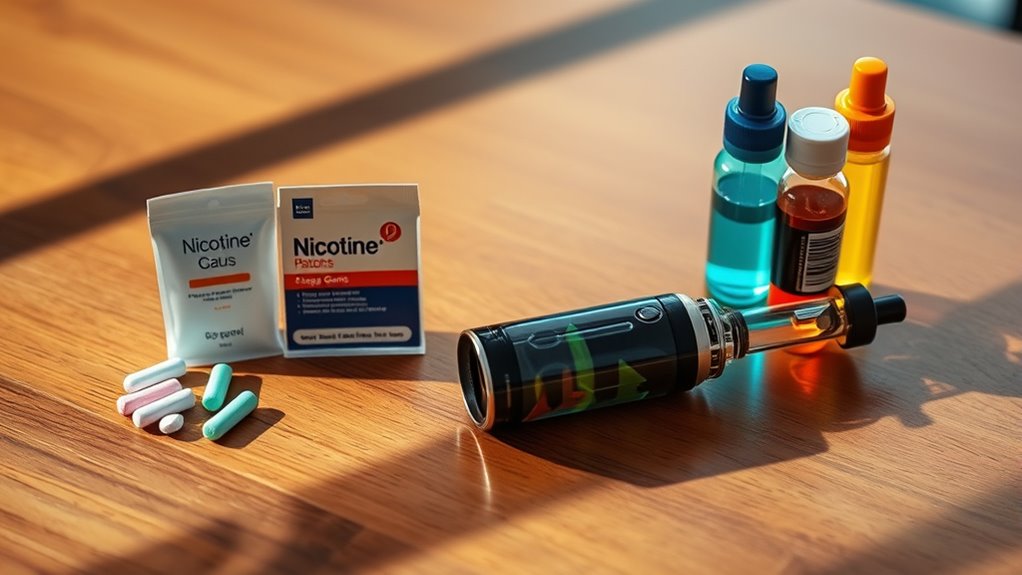When you’re deciding between Nicotine Replacement Therapy (NRT) and vaping, it’s important to know their differences. NRT includes patches, gum, and lozenges that deliver controlled nicotine without harmful smoke. It’s proven effective and recommended by health professionals. Vaping, however, mimics smoking but lacks medical endorsement and poses unknown long-term risks. Your choice might depend on personal preferences and health considerations. Explore deeper into the nuances of each method to find what works best for you.
Key Takeaways
- Nicotine Replacement Therapy (NRT) includes patches, gum, and lozenges, delivering controlled doses of nicotine without harmful cigarette chemicals.
- Vaping involves e-cigarettes that vaporize nicotine solutions, mimicking smoking behavior but exposing users to potentially harmful substances.
- NRT is medically approved and has a proven track record of effectiveness, while vaping lacks official endorsement and its long-term effects are still under research.
- NRT is socially accepted and reduces stigma, while vaping’s acceptance varies by location and community.
- Personal preferences, health risks, and social perceptions play significant roles in choosing between NRT and vaping for nicotine cessation.

When you’re trying to quit smoking, you might wonder: which is better for you, nicotine replacement therapy or vaping? Both options aim to help you manage cravings and reduce your dependence on nicotine, but they come with different implications for your health and social acceptance. Understanding these factors can help you make a more informed decision about which path to take.
Nicotine replacement therapy (NRT) includes products like patches, gum, and lozenges. These methods deliver a controlled dose of nicotine without the harmful chemicals found in cigarettes. NRT has a long track record of effectiveness and is often recommended by health professionals. Since they’re medically approved, you can feel more secure knowing that you’re using a method with established benefits and fewer health risks. Many people find that the social acceptance of using NRT is also higher, as it’s generally seen as a responsible approach to quitting smoking. You won’t have to deal with the stigma that sometimes comes with vaping, especially in places where smoking is still frowned upon.
Nicotine replacement therapy offers a safer, socially accepted way to quit smoking with proven effectiveness and fewer health risks.
On the other hand, vaping has gained popularity in recent years, often marketed as a less harmful alternative to smoking. While many vapers argue that it’s a cooler or more socially acceptable way to get your nicotine fix, the health risks associated with vaping aren’t negligible. Studies have shown that e-cigarettes can still expose you to harmful substances, and the long-term effects are still being researched. If you’re not careful, you might find yourself facing health complications down the line. Plus, the social acceptance of vaping can vary greatly depending on where you live. In some circles, it’s embraced, while in others, it’s met with disapproval, especially among those who are concerned about the health implications.
Ultimately, the decision between NRT and vaping comes down to your personal preferences and circumstances. If you value a medically endorsed method with fewer health risks and greater social acceptance, NRT might be your best choice. However, if you’re drawn to vaping’s convenience and perceived social perks, be mindful of the potential health risks involved. Additionally, understanding the best practices for quitting smoking can further enhance your chances of success. Whichever route you choose, remember that the goal is to quit smoking for good, and finding the right method for you is a vital step in achieving that.
Frequently Asked Questions
Can Nicotine Replacement Therapy Cause Weight Gain?
Yes, nicotine replacement therapy can cause weight gain for some people. When you quit smoking, your metabolism may slow down, leading to potential weight gain. Additionally, the absence of nicotine, which can suppress appetite, might result in increased hunger and cravings. It is crucial to monitor what you eat and stay active to manage these metabolic changes. If you’re concerned, discussing strategies with a healthcare professional can help you navigate this challenge effectively.
Is Vaping Safer Than Smoking Traditional Cigarettes?
Vaping isn’t risk-free, and while it may be safer than traditional smoking, it still poses significant health risks. You’re inhaling chemicals that can affect your lungs and overall health. Plus, the addiction potential of vaping can be just as high as smoking. If you’re looking to quit, consider the long-term effects of both options before making a decision. Always prioritize your health and look for safer alternatives.
Are There Age Restrictions for Purchasing Nicotine Products?
Absolutely, there are age restrictions for purchasing nicotine products! In most places, you’ve gotta be at least 18 or 21 years old, depending on local laws. These legal age requirements help keep nicotine products out of the hands of minors, which is vital since addiction can hit hard. So, if you’re thinking about buying these products, make sure you know the purchase restrictions in your area to avoid any legal trouble!
How Long Should One Use Nicotine Replacement Therapy?
You should generally use nicotine replacement therapy for about 8 to 12 weeks, but it can vary based on individual needs. During this time, keep an eye out for side effects like dizziness or irritability. If you’re still struggling after this period, consult your healthcare provider for duration guidelines tailored to you. They can help you determine if you need to extend use or switch to other methods for quitting.
Can I Combine Vaping With Nicotine Replacement Therapy?
You can combine vaping with nicotine replacement therapy, but it’s not without risks. Imagine juggling two flaming torches; while you might feel in control, the heat can intensify your dependency concerns. Dual use can lead to increased nicotine intake, making it harder to quit altogether. It’s essential to monitor your consumption and talk to a healthcare professional about your options to guarantee you’re on the right path toward breaking free from nicotine.
Conclusion
In the showdown between nicotine replacement therapy and vaping, it’s crucial to consider your choices carefully. While nicotine replacement offers a structured solution to stop smoking, vaping can be a tempting trap that prolongs dependency. Ultimately, prioritizing your health is paramount. By making informed decisions, you can pave the path to a nicotine-free future. So, whether you choose patches or pens, remember: your well-being is worth the wise, winning choice.









